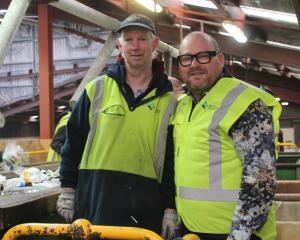Civil defence authorities now say water "may well" enter the Mataura paper mill and trigger an ammonia gas reaction, but the risk to humans or wildlife is considered minor.
Thousands of tonnes of a potentially dangerous chemical — known as ouvea premix — are stored in the the former Carter Holt Harvey paper mill, located next to the Mataura River.
The dross from the New Zealand Aluminium Smelters' (NZAS) Tiwai Point smelter is classified as a class 6 hazardous substance, which can generate poisonous ammonia gas if it comes into contact with water.
Southland Civil Defence Emergency Management group controller Angus McKay this afternoon told the Otago Daily Times flood waters were now "right on the level" where they could flood through the building.

The river itself was also running so high that any ouvea premix released into the water would be diluted to the point it was unlikely to pose a threat to wildlife, he said.
"With the water levels as they are now, we may well get some water going into the paper mill, but we’ve got that evacuation zone in, so I’m not too concerned about ammonia gas.
"I think that will disperse way before it becomes an issue for anybody, and there’s so much water going down the river that by the time it leaches out into the river it’s going to be so dilute that the possibility of it doing anything to the wildlife is really low as well."
Fire and Emergency NZ staff and contractors had done "the best they could" to sandbag the building and protect it from flood waters, and none had been exposed to ammonia gas — despite some media reports, he said.
About 10,000 tonnes of ouvea premix was stored in sacks on stacked pallets inside the old plant.
Australian company Inalco Processing Ltd was last year awarded a contract to remove about 22,000 tonnes of the substance from the paper mill and other sites in Invercargill, but the work was expected to take six years.
In 2018, Gore District Council chief executive Steve Parry said Mataura had come close to environmental disaster during a flash flood earlier that year.
The dross was previously owned by Taha Asia Pacific, which went into liquidation in 2016 and in March 2018 a $4 million package to remove the substance was brokered by the NZAS, the Government and Southland councils.
The contract ensured the 10,000 tonnes of premix stored near Mataura would be moved first, due to the "significant risks posed to both the environment and people by having the premix stored next to the Mataura River", Mr Parry said at the time.
Mr McKay said he did not believe water was yet flooding through the building, but "we’re really right on the level where it could do".
"At the moment it’s looking good — but that could change. We’re nearly there."

Environment Southland welfare officer Mark Oster said he believed the risk from the chemicals was the main reason why the town was evacuated.
Residents angry
Sharon Argyle, who has lived in Mataura for 64 years, said she was not happy when the council "left all that toxic stuff" at the paper mill and that the issue had been allowed to rumble on for so long without a solution.
“They were pretty slow and now it’s too late. I’m blaming [Gore District] council for everything that is happening with Mataura people.
“The only reason to they evacuated us is the toxic at paper mill. If it was was not there, I believe we did not need to leave.”

Doctors Rd resident David Keaton said even though council staff had advised people to go to higher grounds, he did not feel comfortable staying in Mataura due to the toxicity risk.
“We have known about this for so long - and council is not doing anything about it. It’s a time bomb.
“We had everybody at our house since yesterday because it is in a higher area - but we decided to come to Edendale to avoid the toxicity.
"Edendale people has been very kind and offering their support."
Advertisement
Comments
How could the council allow such a larger quantity of nasty stuff to be stored next to a river that has a history of flooding???
Makes me wonder what they spend their mental capacity on !!!
The management and shareholders of Rio Tinto, and every politician and bureaucrat responsible for allowing this stuff to be stored in such an unsafe facility deserves to go to jail for life.
This situation is outrageous. The relevant authorities have known about this risk for YEARS and still nothing has been done. The issue has been well documented in the media and is well-known in Mataura. The consent to store the premix should never have been granted in the first place and the risks were spelt out in detail at that stage - and ignored. This is a very serious dereliction of duty by the Gore District Council and others and the possible outcome is disastrous. And are the livestock in the area being evacuated too? Or will they all be left to die if ammonia is released from the mill? And how long before the area is safe to return to? What about the Mataura River - will that be contaminated and for how long? So many serious questions to answer. This is a total disgrace and was absolutely avoidable if the local authorities had taken notice of the residents' very real concerns. Heads should roll over this and the Government should set up an inquiry. An appalling state of affairs.













